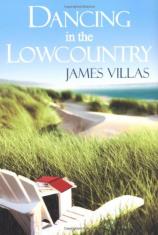Interview: October 10, 2008
October 10, 2008
James Villas, the former food and wine editor of Town & Country magazine as well as the author of several cookbooks, recently published his first work of fiction, DANCING IN THE LOWCOUNTRY.
In this interview with Bookreporter.com's Lourdes Orive, Villas explains his personal connection with the South Carolina coast, where the story takes place, and discusses the real-life inspirations behind its characters and settings. He also elaborates on the importance of food in his work, creates the perfect menu for a Southern meal over which book clubs can discuss the novel, and shares details about what he is working on next.
Bookreporter.com: The South Carolina Lowcountry (the coastal counties of South Carolina) is an integral character in your new novel, DANCING IN THE LOWCOUNTRY. What is your personal relationship to this area?
James Villas: My exposure and close relationship with the Lowcountry began as a child when I vacationed there with family and friends, and continues to this day on a fairly regular basis. After Charlotte, I've always considered the Lowcountry to be my second Southern home.
BRC: Ella Dubose, the protagonist in your novel, is the quintessential Southern lady. A few years ago you wrote MY MOTHER’S SOUTHERN KITCHEN, a book of “recipes and reminiscences.” In what ways did you base the character of Ella on your mother, or other women like her?
JV: Actually, I've written three cookbooks on my mother's Southern food, and while Ella Dubose is a much more complex woman than my mother, many of Mother's traits and habits do certainly figure into the composite character I created in the novel --- and Ella is a composite of many types of Southern ladies I have known.
BRC: Ella and Goldie’s relationship is complex. What made you decide to make Goldie Native American? What elements of her background appealed to you for this character?
JV: First, Goldie is NOT a "Native American" but an "American Indian" --- an important point made in the novel. She is based roughly on a North Carolina Cherokee woman I once knew and greatly admired and is intended to form a sharp contrast with the character of Ella, while also serving as a key to much of what makes Ella tick. Although unsophisticated, Goldie has innate goodness, intelligence, innocence and honesty that can subtly undermine some of the bigotry in the novel and even Miss Ella's putative cultural and moral superiority. Often, Goldie is the voice of common sense.
BRC: The relationships between mothers and their sons --- both Ella’s and Goldie’s --- play a significant role in this novel. How would you characterize your own relationship with your mother?
JV: My relationship with my mother is and always has been very close but complex --- based more on mother/son love and respect for one another than on chummy friendship or intellectual needs. I've never perceived my mother as anyone other than a wonderful mother --- plain and simple.
BRC: Ella is crazy about dancing, hence the title, and your descriptions of the shag were so vivid that I actually searched online to see if I could find videos of this dance! Are you, or is someone in your family, particularly fond of dancing?
JV: I am the dancer in the family --- much of my youth was spent shagging, etc. at most of the famous venues on the Grand Strand, and I even taught ballroom dancing at a dance studio in Charlotte while in high school. Since I also played football, the newspaper once ran a photo of me in uniform entitled "Twinkletoes of the Gridiron." Today, I still occasionally attend a shaggers weekend at Fat Harold's (Fast Eddie's in the novel) at Ocean Drive (North Myrtle Beach, S.C.), which is where you can see the shag in all its glory.
BRC: The character of Earl is left somewhat unexplored, since he’s really seen primarily from the vantage point of Ella’s memories. What would you like your readers to know about him?
JV: There's very little more to know about Big Earl than the way he's portrayed in the novel. Earl is the quintessential Southern male (yesterday and today), who is a product of his environment, who will never change or develop, and who simply remains a member of the tribe, as expected. He is static, and if he were forced to move from his familiar, comfortable, secure Southern setting, he would fall apart. Ditto for his son, Little Earl. These are not bad men; they're simply very limited in cultural sophistication and imagination and have few horizons beyond family, monetary success and sports.
BRC: Society’s view of homosexuality is explored here through the characters of Tyler and Jonathan. Obviously, times have changed and Tyler’s experience is different from that of Jonathan. Do you think that being Southern impacts the way either of these men face this aspect of themselves?
JV: Indeed, being Southern has tremendous impact on the ways both Jonathan and Tyler must face their homosexuality, but it's up to the reader to determine any different societal and moral changes that might have occurred between the times that Jonathan was forced to kill himself and Tyler chose to flee his homeland. Being gay in the South has never been the same experience as being gay elsewhere.
BRC: What role does Edmund’s family play in this story? Why introduce them, as opposed to having Edmund meet Ella alone?
JV: There has to be a plausible framework in which Ella can meet Edmund, and what makes more sense than having the lonely old gentleman on vacation with his family? The Marianis provide an interesting cultural contrast in studying the role of family in the North and South, and they also provide a reason for Edmund to have his own secrets to share with Ella. Further, the relationship between Goldie and the young children is important in the overall arc of the story.
BRC: The relationship between Ella and her two younger children, Earl Jr. and Olivia, is strained by their current desire to limit their mother’s independence, and you state in the novel that Ella’s relationship with Tyler was always especially close. What was childhood like for Earl Jr. and Olivia? What’s next for them?
JV: Little Earl's and Olivia's childhood was no more, no less conventional than what is portrayed in the novel --- in contrast with Tyler's. They led a typical, "normal," healthy childhood that would have caused no worry to either parent, and their futures, like those of most Southern children of their class, were predestined: marry, breed, make money, and tend to family. What's next for them? Absolutely nothing. Change is forbidden.
BRC: You have a well-established reputation as a food and wine editor for over 27 years. What made you want to write fiction?
JV: This is not my first work of fiction, only my first published fiction. My life has been highly literary since my early education and teaching career, but only when I was able to relinquish my duties as a food editor (to make a living) did I find the freedom to fully engage in fiction. Also, much of my food and other writing for magazines often has a fictional twist in both content and style.
BRC: Naturally, given your food-writing background, your descriptions of Lowcountry meals are mouthwatering, and many of the characters connect over memorable meals. What role does food and cooking play in the lives of your characters?
JV: Food has always played an important role in the works of certain great novelists (Balzac, Proust, Welty, Auden, Hemingway), and I can't imagine portraying the lives of characters without describing what they eat and cook and drink. If not, a whole dimension of existence is missing. And to write a story about the South without Southern food playing an important role would be inconceivable for me. So natural is the instinct, in fact, that I was actually unaware of all the food in this novel until it was pointed out to me.
BRC: The Priscilla, the genteel Myrtle Beach Inn where so much of the action takes place, is almost like another character in the novel. Does the Priscilla exist, or was it based on an actual location?
JV: The Priscilla did indeed exist at Myrtle Beach until about two decades ago and was called The Patricia in reality. My family and I stayed there many many times over the years, and older locals still remember it with great nostalgia. Like the Ocean Forest and other genteel hotels and inns of yesteryear, it was eventually taken over by the philistines and reduced to commercial trash. Today there is nothing like it anywhere on the Grand Strand.
BRC: Naturally, DANCING IN THE LOWCOUNTRY begs to be discussed by a book club over a fantastic Southern meal. Any recipe recommendations for your readers?
JV: An appropriate menu would be some soused shrimp, fried chicken or pork barbecue, coleslaw, cups of Brunswich stew, hush puppies, a sticky peach cobbler, and, of course, pitchers of ice' tea. The main dish in and around Charleston might be an elaborate chicken perloo or shrimp bog, and, for dessert, a rich Huguenot torte.
BRC: What are you working on now, and when might readers expect to see it?
JV: I'm presently writing another Southern novel called FAT GIRL, which is totally different in subject and style from DANCING and should be out late next year.




